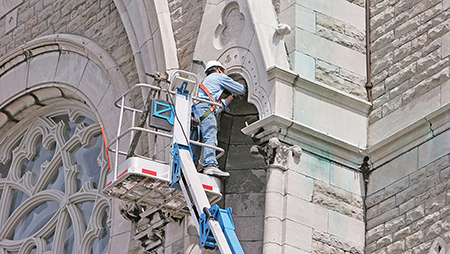
By Skylar Griego
As we start wrapping up the year and shopping for 2020 planners, now is a good time to look back on 2019 and see the big picture that’s formed throughout the year. At Church Executive, that means taking a look at which articles were most important to our readers.
We cover a wide range of important topics for church leaders — from staff training tips, to church growth solutions, to church financing, we talk to experts from all facets of church administration and leadership to bring you the best information you can use.
When we looked at this year’s 15 most-read articles, the editors noticed there were five primary categories that you, our readers, were most interested in:
- Church Finance
- Church Leadership & Management
- Church Design & Construction
- Lifetime Learning
- Risk Management
Church Finance
As important as it is to manage your ministries, every senior pastor knows you can’t let finances fall by the wayside. Here are the finance articles our readers found to be the most helpful this year.
 Why you need an emergency fund — and how to build one
Why you need an emergency fund — and how to build one
As temperatures increased in summer of 2019, the United States also saw a rise in natural disasters, mass shootings and other emergency situations churches can experience. Luckily, early in the year we published this article about building an emergency fund for your church just for these kind of events.
“The cornerstone of a successful financial plan — and one of the keys to achieving financial wellness — is having an emergency fund.”
This vital advice comes from Certified Financial Planner® Alina Parzianu, a financial planning specialist at MMBB Financial Services. Drawing from her 14 years of experience in the financial services industry, Parzianu answers questions about how much to put in an emergency fund, where to keep it, how to start it, how to prioritize it with competing debt, and how to stick to emergency fund saving goals.
 10 tips to prepare your church for financing ministry expansion
10 tips to prepare your church for financing ministry expansion
Even when there’s no emergency happening in your community, it’s just as important to make sure you’re prepared for the expected as well as the unexpected. This great article helped our readers do just that with tips for funding ministry expansion for your church.
This expert information comes from Kari Boyce and Chris Lewis of Thrivent Church Financing, a faith-based lender based in Minnesota.
“Growing ministries face financial and facility capacity constraints on a regular basis,” they wrote. “One important question is, ‘How does a ministry prepare for financing its growth?’”
The 10 tips given from a lender’s perspective help readers to answer that exact question.
 5 healthy church budgeting guidelines
5 healthy church budgeting guidelines
You can find a ton of information about budgeting and personal finance on the internet, including the Church Executive website. In some ways, managing finances for a church is very similar to managing your own personal finances. However, there are also some key factors that are unique to money intended for church administration. That’s why we brought you this article with five great guidelines to keep in mind when you’re managing your church’s budget.
These five financial goals come from Meaghan Kelly at AkitaBox, a facility management software provider. In this popular article, she teaches readers how to do the most good with even the tightest of church budgets using financial planning.
“Church administrators and facility managers should develop a healthy, long-term financial plan before spending any funds,” Kelly said.
To help with this, she discusses projected income for the church, planning for maintenance, cost analyses and more.
Church Leadership & Management
As we head into the next decade of the 21st century, it’s important to evolve with the times to keep members engaged with your ministry. This doesn’t just apply to technology in the digital age — leadership styles are also evolving. Here are some great resources for today’s modern church leader.
 Leading a legacy
Leading a legacy
In 2001, Word of Life Church faced two major setbacks: the senior pastor passed away, and the building project — underway at the time — came back from bid 200% over budget.
But, 10 years later, the church completed an $11.2-million building project, including a 900-seat sanctuary, offices, adult education areas, café, and state-of-the-art facility for infants, children and youth.
This is the legacy of Pastor Joel Sims, and his experience serves as a case study for how great leadership can overcome adversity for even the most daunting of church projects.
It took two building phases, more than a decade, and a unique partnership with Churches by Daniels to complete the dreams of Joel’s late father Ronnie — but in the end, World of Life Church grew into a megachurch suited to serve its community for generations to come.
“Today, what started as Ronnie Sims’ $10-million building project has culminated in a nearly $30-million, family-friendly church campus. According to plan, Word of Life Church is even on track to be debt-free in as little as three years.
It’s no small feat for any church, let alone one that has navigated such a personal tragedy, along with significant building setbacks. Joel said he gets emotional about that fact at least once a week, when he pulls up to the campus.
 Leadership development options for busy church leaders
Leadership development options for busy church leaders
The modern church leader is a busy person. There are facilities, finances, ministries, and so much more that need constant management. On top of all this, it’s important for pastors to maintain their own personal growth as well. But what does that look like for today’s busy pastors?
To find out, we brought together four experts from some of the leading seminaries in the country and asked them to break it down for our readers. In this summer 2019 roundtable, representatives from North Greenville University, Center for Church Management at Villanova School of Business, Ashland Theological Seminary and New Orleans Baptist Theological Seminary answer the important question on many pastors’ minds: What skills are most in-demand today — and how can you make this training work for you?
 How data can drive better ministry
How data can drive better ministry
In this day and age, we have data on everything. From finances to demographics to interests, we can record just about any information we want into a database for any given group. Churchgoers are no exception, and this can be a huge asset to the modern church.
Church management software is a treasure trove of actionable information — but only if you know how to mobilize it. To help you learn how to get the most of out of this ever-evolving tool, Church Executive spoke with Gordon Proud, director of sales and marketing at ChMS provider Shelby Systems in this Q&A.
In it, Proud discusses overlooked ChMS data points, automation, data benefits to outreach and discipleship, and more.
“Developing an effective assimilation process — and building a core team of people to use the information securely and responsibly — will only help a church grow and reach more people in its community,” Proud said.
 4 ways to nurture your community & engage your congregation
4 ways to nurture your community & engage your congregation
Engagement is at the heart of every good leadership approach, whether you’re the senior pastor, a church business administrator or a leader on the board with a designated jurisdiction. That’s why Church Executive partnered with Troy Pollock, chief ambassador at Pushpay, in this article to educate readers on some of the best methods for nurturing your community and engaging your congregation.
At its core, Pollock’s advice centers on four key points:
- Know your audience
- Make them feel seen
- Reciprocate generosity
- Encourage meaningful participation
“A recent study from Barna found that while the majority of pastors are optimistic about the future growth of their church, nearly 75% of churches do not have a formal strategy in place to achieve that growth. While every church wants to reach new people and better engage with those who are already a part of their community, many don’t know where to start,” Pollock said. “[These] four steps create meaningful interactions with your congregants and keep them engaged throughout their journey in ministry.”
Church Design & Construction
Many pastors find that as their church membership grows, so does their need for space to accommodate a growing congregation. Here are some great case studies published this year of how to go about this process.
 A heart for the ministry of building & construction
A heart for the ministry of building & construction
A call to ministry can happen to anyone, so it’s not surprising that executive pastors across America come from a variety of backgrounds. Sometimes, if the church is lucky, that background can even help contribute to some of the projects the church’s ministries are planning.
This was exactly the case for Executive Pastor Jeff Wilson and Severns Valley Baptist Church. When the church embarked on a $16.5-million building project in 2016, Wilson was able to draw on his background of working in construction during college, as well as his knowledge gained while pursuing plans to be an architect before he was called to serve God in the church. In addition to this, Wilson had experience working with other churches for building things like a Family Life Center and working on multiple remodeling projects.
His expertise and experience were vital in the search for a partner for this latest project — which is how the Severns Valley church team found itself working with Visioneering Studios, a nationally licensed architectural and construction firm with offices in California, Texas, Tennessee, and North Carolina.
“They truly heard our desires and didn’t try to make them fit into their preconceived ideas or model,” Wilson recalled. “They also helped us to think about options outside of our own preconceived ideas and models.”
Now, nearly four years later, the project has been complete with the construction of a worship center, additional parking spaces, new lighting both outdoors and indoors, an 80-foot cross, colorfully lit hallways facing the community, and an especially popular outdoor event space called The Lawn.
Not only has all of this expansion helped Severns Valley realize its dream of being a community church — it’s all been done under budget.
Given their deep involvement in the project, Serverns Valley leaders weren’t surprised to come in under budget, despite an expanded scope; however, it’s been a downright shock to others.
“We’re contacted often by church leaders about our project, and they’re somewhat skeptical when we mention it,” Wilson said.
Wilson and his team at Severns Valley credited this achievement to their architectural / building partnership — an excellent case study in how to get the most out of your budget for a building project to expand your church.
 4 core values your church must address in secular society
4 core values your church must address in secular society
In this post-Christian era the world is currently experiencing, many churches are battling declining memberships and being challenged in their ability to have a significant impact. How can your church go on the offensive to defend its significance and connect with an increasingly secular society?
To answer these questions, Church Executive partnered with Jennifer Wise, director of marketing and public relations at Churches by Daniels Construction.
Wise suggested that struggling churches consider strengthening four core areas to overcome stereotypes that might hinder people from giving your church a chance. The four tips she gave are:
- Strengthen your vision and your mission.
- Beef up your social media.
- Engage the community from your doorstep.
- Change your carpet.
That last one might seem a little inconsistent with the other advice on this list, but Wise makes the case that property appeal is an important benefit for your church.
“An investment in your facilities affects people’s mindsets. If they walk into old, tired facilities, they might feel tired and old themselves,” Wise said. “On the other hand, if they walk into fresh, clean, newer facilities, they’re impacted in a different, far more positive way.”
“As churches, we have a very limited amount of time to make a first impression,” she said. “So, take stock of where your church is right now, and strengthen the areas that need it.”
Lifetime Learning
Whether you’re brand new to your ministry or you’ve been leading your church for most of your lifetime, it’s never too late to learn more about great church leadership. Here are two great resources from this year to help you get started on your next pathway for learning.
 Equipping pastors for counseling
Equipping pastors for counseling
Being the leader of a church comes with many responsibilities. Some are obvious, like managing church facilities and ministry planning. Some responsibilities, however, are the result of more recent phenomena that weren’t necessarily as expected by the clergy community as a whole, so even pastors who have gone to seminary aren’t necessarily prepared to meet the needs of their congregations.
One of these less obvious responsibilities is counseling. Many people are turning to their pastors for comfort and advice when dealing with a variety of situations both in and outside of the church.
So how can you prepare to provide the help and guidance needed for your congregation? To answer this, Church Executive spoke with Yvonne N. Glass, PhD., LPCC-S, the director of clinical mental health counseling programs at Ashland Theological Seminary.
In the interview, Glass answered questions about multiple aspects of this important topic, including the state of most pastors’ current counseling abilities; the liabilities and risks involved in providing counseling; the areas of counseling training currently most in-demand; Ashland Theological Seminary’s training programs; options for busy church leaders interested in training; cost considerations; and more.
“Pastors are prepared for pastoral counseling. Some are certainly well-equipped to deal with parishioners’ spiritual and emotional issues. Many more are reasonably equipped to do ‘non-clinical’ counseling, such as grief and pre-marital counseling,” Glass said. “They likely aren’t prepared for clinical counseling, however. Many of the concerns congregants bring to them are clinical: depression, anxiety, bipolar disorder and so on. Sometimes the severity of the mental illness isn’t identified due to lack of training. As a result, most pastors would do well to develop their referral skills and resources.”
 Advancements in MDiv & DMin Training
Advancements in MDiv & DMin Training
This year, Church Executive readers showed extra interest in pursuing a formal education in ministry. But as some of the other Top 15 articles have illustrated, today’s church leaders are busier than ever. For busy full-time church leaders, an MDiv or DMin degree might seem out of reach.
To shed some light on the reality, we teamed up with experts from two different seminaries for a discussion on the options available to today’s leaders.
Reggie Ogea, associate dean for professional doctoral programs at New Orleans Baptist Theological Seminary (NOBTS), and Mignon R. Jacobs, dean at Ashland Theological Seminary, answered questions about various aspects of continuing education for church leaders.
Their key point: pursuing degrees to fulfill your calling is now more accessible than ever.
“We’re always seeking to be flexible in our course schedules, but perhaps the biggest change has been using video learning methods,” Ogea said. “This includes live interactive video (where students can participate as if they were sitting here in class) to recorded video sessions that allow students to participate when their schedules allow.”
“A key part of our DMin program is offering multiple pathways for degree completion, including evening and weekend courses for MDiv students — among whom an increasing number opt to complete their degree part-time, or to remain in their local or regional context. Online and hybrid formats allow for this,” Jacobs said.
Risk management
Now more than ever, safety is of the utmost concern for churches all over the world. Churchgoers this year witnessed tragedies in houses of worship time and again, and church leaders are more determined than ever to keep their members safe. Here are four great articles from 2019 to help you make sure your church won’t be the next victim.
 4 tips for increased church childcare safety
4 tips for increased church childcare safety
We can all agree that the highest safety priority for every church leader is keeping the children who attend safe from all threats — both within and outside of the church. In light of recent attacks as well as the abuse scandals that were uncovered this year, it’s important now more than ever to take steps to ensure the safety of your church’s youngest members.
A good place to start is with these four tips for increased church childcare safety from Elizabeth Norman, director of risk control for Glatfelter Religious Practice, a leading insurance program for churches, synagogues, temples and other religious institutions.
Her four tips are:
- Carefully vet all hires and volunteers.
- Set strict exchange protocols.
- Implement sexual harassment training and reporting.
- Boost your security.
In the article, Norman elaborates on each of these tips and how to best approach establishing these policies and procedures for the safety of your church’s kids.
“A bit of proactive preparation goes a long way to keeping your church’s youth safer and giving congregation members peace of mind,” she said.
 Disaster recovery & communications
Disaster recovery & communications
People aren’t the only thing church leaders have to protect their congregants from. Natural disasters can be just as dangerous and damaging to your church without proper preparation and execution of safety plans.
We can’t prevent natural disasters from happening, but we can prevent worsening the problem with a poorly executed recovery plan. To help our readers know how to prepare and keep their members safe, we spoke with Hillary Keller Bowling, program manager at One Call Now, and Matthew McMaster, a services consultant at FellowshipOne, about the most important things to know when disaster strikes.
Having a plan in place for a “recovery ministry” is key to implementing an effective disaster recovery strategy, they said. You want to make sure to have a team of people with skills that can benefit the recovery process ready to take action if disaster strikes.
“Identify and recruit active members of the congregation with specific skills, such as medical, emergency response, law enforcement, facilities management, and volunteer coordination expertise. Your ChMS should make it easy to vet volunteers. Make sure there’s a link to seamless background checks included,” McMaster said. “In addition, this recovery team needs a plan. Think through different scenarios … Disaster recovery teams should familiarize themselves with federal, state and local data sources to determine the risks in any given area.”
In addition to providing information about effectively planning your team, Keller Bowling and McMaster answered questions about the strategies a church should adopt now (before disaster strikes), during and after a disaster occurs and what effective tools will make this process easier.
They also remind us that any tool church leaders use in these scenarios is only as good as the information they have for it.
“Many churches don’t have up-to-date contact information for the majority of their members. In case of an emergency, you can’t count on a manual phone tree to be enough to get your message out quickly and accurately,” Keller Bowling said. “Remember: keeping the contact list up to date is the most important part of any communication plan.”
 Cyber security & your church
Cyber security & your church
On top of all of the physical risks church leaders have to worry about, it’s also important to remember that in today’s digital age, your church is vulnerable to cyberattacks as well, which can be just as damaging to your members as physical attacks.
Cyber criminals are notorious for seeking out organizations that seem unsuspecting. Unfortunately, churches are often exactly what they’re looking for. Giving ministries and church building projects are among scammers’ favorite targets for financial theft through the web.
That’s why we once again spoke with Elizabeth Norman, an expert in risk control at Glatfelter Religious Practice, to help readers learn how to keep their churches secure online.
After discussing a sad case study of a church that was scammed out of approximately $1.75 million through fraudulent wire money transfers, Norman offers these tips for keeping your church from being the next scammer’s victim:
- Use cautious clicking.
- Get smart about passwords.
- Change your passwords frequently.
- Protect your PC with anti-virus software.
- Keep communicating on the issue of cyber security regularly.
“The more aware you are of cybercrime red flags, the better. Professional hackers use cutting-edge technologies to steal identities, information, credit card numbers and money,” Norman said. “They demand ransoms, rewire funds, use phishing scams or request gift cards. They crawl into databases when someone clicks on a bad link or tries to download a document. Share these tips with all church members to keep everyone as aware and proactive as possible.”
 Theft, fraud & embezzlement: how to protect your church
Theft, fraud & embezzlement: how to protect your church
It’s not always a faceless hacker or scammer somewhere behind a computer that you have to worry about. Financial loss can also be caused by people within the church if you’re not careful.
We hear stories of it all the time: people in the church who have committed theft, fraud or embezzlement.
“Sometimes the culprit is the church accountant who intentionally misrepresents church spending. Sometimes it’s the church food pantry director, who purchases food for the church — and $30,000 in Visa gift cards over time. Sometimes it’s an outside thief who breaks into the building and takes irreplaceable art or books. And sometimes it’s even the admired pastor himself,” Glatfelter Religious Practice’s Elizabeth Norman said in this popular 2019 article on risk management.
Though no one wants to think their fellow church members could be capable of such crimes, the truth is it’s possible. That’s why Norman shared these theft red flags and fraud-prevention best practices with our readers to help them know the signs and keep their churches protected.
Theft red flags:
- Single-person control of the church’s funds
- Too much interest in valuable items
- Careless counting and record-keeping of spending
- Always-open entryways
Fraud-prevention best practices:
- Schedule a site security assessment
- Develop a written safety and security plan with up-to-date contacts and roles
- Train everyone involved
- Ensure that trust is earned with new employees and volunteers
“Putting careful procedures into place before these things happen can help to save your church from sizable losses,” Norman said. “It’s important to band together to watch for red flags, exercise best practices and keep communication open so that, all across your parish, others do the same. These simple, small tasks can go a long way to protecting your church and its fellowship.”


